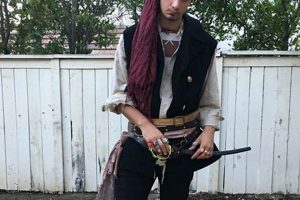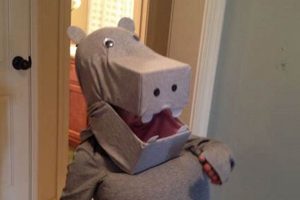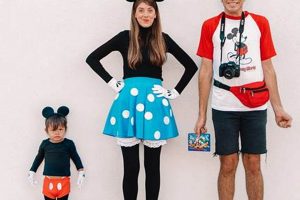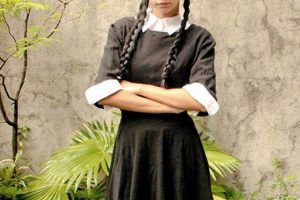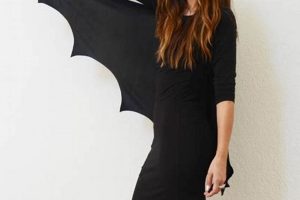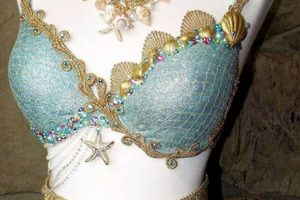Creating a handmade White Rabbit outfit, inspired by the character in Lewis Carroll’s Alice in Wonderland, involves constructing a recognizable ensemble through individual effort and available materials. Such projects typically include elements like rabbit ears, a waistcoat, a pocket watch, and formal attire to mimic the character’s depiction. For instance, individuals might sew custom rabbit ears using felt and wire, repurpose a thrift store vest, and craft a large pocket watch from cardboard and paint.
The significance of constructing this type of attire lies in the creative engagement it fosters and the personalized outcome achieved. These projects provide an opportunity for individual expression and resourcefulness. Historically, homemade costumes allowed individuals to participate in events and celebrations without incurring significant expense, fostering community involvement and imaginative play.
The following sections will explore specific methods for developing various components of this particular character representation, including options for adapting pre-existing clothing, constructing accessories, and achieving a visually authentic final product.
Tips for Constructing a White Rabbit Ensemble
The creation of a White Rabbit-inspired outfit necessitates careful planning and attention to detail. The following suggestions aim to provide guidance in assembling a cohesive and recognizable representation of the character.
Tip 1: Prioritize the Waistcoat. A well-fitting waistcoat is central to the White Rabbit’s appearance. Consider sourcing a second-hand garment and modifying it with fabric paint or additional embellishments, such as decorative buttons, to enhance its visual appeal.
Tip 2: Emphasize Timekeeping. The pocket watch is an iconic accessory. If a functional pocket watch is unavailable, a convincing replica can be crafted from cardboard, foam, or readily available craft materials. Attention should be given to the accuracy and detail of the clock face.
Tip 3: Craft Durable Ears. Rabbit ears are crucial for identification. The use of sturdy wire for the internal structure, combined with felt or faux fur for the outer covering, will ensure the ears maintain their shape and upright position throughout wear.
Tip 4: Accessorize Thoughtfully. Consider incorporating additional accessories that enhance the character’s portrayal. These may include a pair of spectacles, white gloves, or a small scroll, referencing the White Rabbit’s role as a herald.
Tip 5: Pay Attention to Footwear. While often overlooked, appropriate footwear contributes to the overall aesthetic. Black dress shoes or boots are suitable choices, reinforcing the character’s formal attire.
Tip 6: Consider Fabric Choice Carefully. When selecting fabrics, prioritize those that drape well and maintain their shape. Avoid overly flimsy or transparent materials, as they may detract from the overall appearance of the attire.
Tip 7: Maintain Proportions. Ensure all elements of the outfit are appropriately scaled to the wearer. Overly large or disproportionately sized accessories can diminish the believability of the character representation.
Successful assembly of this character representation relies on a strategic approach to material selection, construction techniques, and attention to detail. By adhering to these guidelines, a convincing and recognizable interpretation can be achieved.
The subsequent section will delve into potential challenges encountered during the construction process and provide strategies for overcoming common obstacles.
1. Timekeeping accuracy
The accurate representation of timekeeping devices is paramount to the success of any White Rabbit costume derived from Alice in Wonderland. The White Rabbit’s anxiety regarding punctuality and his ever-present pocket watch are defining characteristics, directly influencing the immediate recognition of the character. A poorly rendered or inaccurate pocket watch diminishes the overall impact of the entire creation. Consider, for instance, a costume utilizing a modern wristwatch: the incongruity immediately detracts from the intended aesthetic and weakens the association with Carroll’s original narrative.
The construction of a credible pocket watch prop necessitates attention to detail. Factual accuracy with respect to the style of pocket watches common during the Victorian era is essential. Circular forms, Roman numeral markings, and period-appropriate chain designs are all elements that contribute to the authenticity of the overall ensemble. Without careful consideration, a homemade prop can lack the impact necessary to convincingly portray the character’s frantic obsession with time.
In summary, meticulous attention to timekeeping accuracy is not merely a cosmetic detail but an essential component that significantly enhances the recognizability and effectiveness of a White Rabbit interpretation. The commitment to historical accuracy underscores the importance of this seemingly small element in establishing a convincing connection with the source material, elevating the creative endeavor beyond a basic imitation.
2. Waistcoat embellishments
Waistcoat embellishments are critical in distinguishing a commonplace vest from a recognizable element of a White Rabbit-inspired garment. The selection and application of these embellishments directly impact the costume’s overall success in conveying the intended character.
- Button Selection and Placement
Button choice significantly alters the waistcoat’s aesthetic. Ornate, vintage-style buttons contribute to an authentic Victorian appearance. Strategic placementavoiding uniform spacing and incorporating varied sizescan enhance visual interest and add depth. Conversely, modern or plain buttons detract from the costume’s period accuracy.
- Fabric Appliqus and Trims
Adding fabric appliqus, such as small clock faces, rabbit motifs, or floral patterns, introduces character-specific details. Carefully chosen trims, like velvet ribbon or lace, can elevate the waistcoat’s perceived quality and contribute to a more elaborate design. The application of these elements necessitates precision and attention to color coordination.
- Pocket Detailing
The inclusion of faux or functional pockets adds another layer of realism to the waistcoat. Trimming the pocket edges with contrasting fabric or adding a small chain leading to a (non-existent) pocket watch creates visual intrigue. Pocket placement and size must remain proportionate to the waistcoat and the overall costume design.
- Embroidery and Stitchwork
Hand-stitched embroidery, particularly with gold or si
lver thread, offers a personalized touch and elevates the waistcoats perceived value. Simple embroidery patterns, such as repeating clock hands or small rabbit silhouettes, can subtly reinforce the character’s identity. This technique requires skill and patience to execute effectively.
The strategic application of waistcoat embellishments is essential for crafting a visually compelling White Rabbit costume. These details transform a generic garment into a recognizable symbol of the character. The success of these modifications depends on careful planning, precise execution, and a commitment to replicating the aesthetics of the original Alice in Wonderland character design.
3. Ears construction
The structural integrity and visual accuracy of rabbit ears are critical to the overall success of a self-made White Rabbit costume inspired by Alice in Wonderland. The ears serve as an immediate identifier, allowing for swift recognition of the character, and their construction directly impacts the aesthetic quality of the finished outfit.
- Framing Materials and Support
The internal structure of the rabbit ears dictates their shape and stability. Options range from malleable wire, allowing for adjustable positioning, to rigid buckram or heavy interfacing, providing a more defined and permanent form. The selection of materials must balance flexibility with the ability to maintain the ears’ upright posture. Inadequate support leads to drooping ears, detracting from the costume’s intended effect. For instance, using thin craft wire without additional reinforcement can result in misshapen ears that fail to project the character’s characteristic alert demeanor.
- Fabric Covering and Texture
The external fabric covering the ear frame impacts the texture and visual appeal of the construction. Faux fur provides a realistic and tactile element, while felt offers a cost-effective and readily available alternative. The choice of fabric dictates the overall impression of quality; for example, a plush, high-pile faux fur enhances realism, whereas inexpensive felt might appear amateurish. Furthermore, the method of attachment, whether glued, sewn, or a combination thereof, influences the smoothness and durability of the covering.
- Proportionality and Scale
The dimensions of the rabbit ears must be proportionate to the wearer’s head and the overall costume. Oversized ears can appear comical or distracting, while undersized ears may fail to effectively convey the character’s identity. Careful consideration of head circumference and overall body size is necessary to achieve a balanced aesthetic. An example would be creating excessively long ears for a child’s costume, which could overwhelm the wearer and impede movement.
- Attachment Method and Security
The method of attaching the rabbit ears to a headband, wig, or directly to the head is crucial for both comfort and security. A poorly secured attachment can lead to the ears slipping or falling off during wear, undermining the costume’s functionality and visual appeal. Options include sewing the ears to a sturdy headband, using strong adhesive, or incorporating hidden combs for added grip. Selecting the appropriate method depends on the weight of the ears, the wearer’s hairstyle, and the anticipated level of activity. A scenario involving dancing or running necessitates a more robust attachment than a static photoshoot.
The successful construction of rabbit ears for a White Rabbit costume requires careful attention to the interplay between framing materials, fabric covering, proportionality, and secure attachment. These elements must be considered holistically to achieve a visually convincing and structurally sound accessory that effectively contributes to the overall character portrayal. The quality of the ear construction directly correlates with the audience’s ability to recognize and appreciate the intended representation of the White Rabbit from Alice in Wonderland.
4. Attire formalness
The level of formality in a self-constructed White Rabbit outfit, inspired by Alice in Wonderland, directly influences the audience’s perception and recognition of the character. The White Rabbit is consistently depicted in formal attire, often including a waistcoat, jacket, and sometimes even a cravat or bow tie. Deviating from this established image diminishes the immediate connection to the source material. A costume lacking these formal elements might be perceived as a generic rabbit costume, rather than a deliberate portrayal of the specific character from Carroll’s narrative. The cause is the character’s established visual representation; the effect is the costume’s success in invoking that image. The selection of fabrics, such as velvet, tweed, or broadcloth, further reinforces this sense of formality, contributing to an authentic representation.
The practical significance of understanding this lies in the design choices made during the costume creation process. Selecting patterns for vests or jackets that reflect historical tailoring techniques, opting for crisp, collared shirts, and ensuring proper fit contribute to the overall impression of formality. For example, a homemade costume utilizing a t-shirt instead of a collared shirt and denim pants instead of tailored trousers would fail to capture the character’s inherent formality, regardless of other accessories like rabbit ears or a pocket watch. Understanding this concept allows the creator to prioritize aspects of the costume that maximize its impact and recognizability. This extends to details such as the careful pressing of fabrics, the selection of appropriate footwear (dress shoes rather than sneakers), and the overall attention to detail in maintaining a polished appearance. A more formal portrayal often resonates strongly with audiences familiar with the source material.
In summary, attire formalness is a crucial component of a successful self-constructed White Rabbit costume. It provides immediate visual cues that link the creation to the established character, influencing audience recognition and appreciation. While challenges may arise in sourcing or constructing historically accurate garments, the investment in these formal elements is a critical factor in achieving an effective and convincing portrayal of the White Rabbit. The impact extends beyond mere aesthetics; it contributes to a deeper connection with the narrative and enhances the overall experience for both the creator and the viewer.
5. Resourcefulness
Resourcefulness plays a pivotal role in the creation of a homemade White Rabbit costume inspired by Alice in Wonderland. The inherent nature of a “do-it-yourself” project necessitates the application of ingenuity and adaptability in acquiring materials and devising construction techniques. This creative problem-solving is not merely a cost-saving measure but a fundamental element in achieving a unique and personalized representation of the character.
- Material Repurposing and Substitution
Resourcefulness often involves identifying an
d repurposing existing materials for use in the costume. For example, a worn-out dress shirt can be transformed into a waistcoat, or cardboard boxes can be utilized to create a pocket watch prop. This approach minimizes expenditure and reduces waste, demonstrating a commitment to sustainable practices. The ability to identify alternative materials that effectively mimic the desired appearance is a hallmark of resourceful costume construction. An example of this would be substituting felt for velvet when crafting rabbit ears, balancing aesthetic considerations with budgetary constraints. - Skill Adaptation and Improvisation
Constructing a complex costume frequently requires adapting existing skills or learning new ones. Individuals may need to refine their sewing techniques, develop proficiency in prop-making, or learn basic pattern drafting. Resourcefulness in this context involves leveraging available tutorials, seeking guidance from online communities, and experimenting with different approaches to achieve the desired result. For instance, if a traditional sewing machine is unavailable, the individual might adapt hand-sewing techniques to create the costume components, showcasing adaptability and problem-solving skills.
- Creative Problem Solving in Design Challenges
During the construction process, unforeseen design challenges inevitably arise. Resourcefulness is demonstrated by the ability to identify and implement effective solutions to these problems. This might involve modifying patterns to accommodate unusual body shapes, devising innovative methods for attaching accessories, or troubleshooting fabric malfunctions. For instance, if a particular fabric proves difficult to sew, the individual might experiment with different needle types, stitch lengths, or adhesive methods to overcome the obstacle. This proactive approach to problem-solving is crucial for completing the costume successfully.
- Utilizing Found Objects and Thrifted Items
Scouring thrift stores, flea markets, and even personal storage spaces for suitable components represents another facet of resourcefulness. Identifying potential costume elements from unexpected sources requires a keen eye and an ability to envision the transformative possibilities of discarded items. A vintage pocket watch (functional or non-functional), found at a reasonable price, can greatly enhance the costume’s authenticity. This also extends to fabric scraps, buttons, and other embellishments that can be integrated into the design, adding unique character and reducing reliance on newly purchased materials.
These varied manifestations of resourcefulness are central to the spirit of “diy white rabbit costume alice in wonderland”. The process encourages ingenuity, adaptability, and a commitment to achieving a visually compelling representation of the character through inventive means. The constraints imposed by budgetary limitations or material availability often fuel creativity, resulting in costumes that are both unique and personally meaningful. The successful completion of such a project stands as a testament to the power of resourcefulness in realizing imaginative visions.
6. Material selection
In the context of a self-made White Rabbit costume inspired by Alice in Wonderland, material selection represents a foundational decision-making process that profoundly affects the final outcome. The chosen materials determine the costume’s visual appeal, durability, comfort, and overall recognizability. A strategic approach to material selection is therefore crucial for achieving a successful and compelling character representation.
- Fabric Type and Texture
The selection of appropriate fabrics directly impacts the costume’s aesthetic. Velvet or tweed, for example, evoke a sense of Victorian formality befitting the White Rabbit’s character. Conversely, less formal materials, such as denim or jersey, detract from this impression. Fabric texture also plays a significant role; smooth, lustrous fabrics create a refined appearance, while rough, matte fabrics suggest a more rustic or casual aesthetic. The deliberate pairing of fabric type and texture with the intended character portrayal is essential. Example, a stiff broadcloth would be appropriate for the White Rabbit’s waistcoat, offering both structure and a somewhat formal appearance.
- Color Palette and Saturation
The color palette of the chosen materials must align with established depictions of the White Rabbit. Predominantly white, cream, or light grey fabrics are typically used for the rabbit’s fur, while darker colors (black, navy, or brown) are reserved for the waistcoat, jacket, and accessories. The saturation levels of these colors influence the costume’s overall vibrancy; muted tones suggest a more understated and historically accurate appearance, while brighter tones create a more whimsical and fanciful effect. Example, avoiding neon or overly saturated colors to maintain a degree of historical plausibility, while still allowing for creative interpretation.
- Durability and Longevity
The selected materials must withstand the rigors of wear and tear. Durable fabrics, such as cotton twill or wool blends, are preferable for garments that will be subjected to frequent use or strenuous activity. Fragile or delicate materials, such as silk or lace, may require additional reinforcement or protective measures. The intended use of the costume (e.g., for display purposes versus active participation in events) influences the acceptable level of durability. If it is to be worn for an extended period, choosing fabrics less prone to snagging or ripping would be wise.
- Cost and Accessibility
Budgetary constraints and material availability often influence the selection process. Resourceful costume creators may opt for less expensive or readily accessible materials, such as felt, craft foam, or repurposed fabrics. The ability to creatively substitute materials without compromising the overall aesthetic is a key skill in self-made costume construction. The aim is to balance the desired appearance with practical limitations, perhaps using faux fur for rabbit ears instead of expensive real fur. Balancing the budget to the fabric look a lot better.
These facets of material selection collectively contribute to the success of a do-it-yourself White Rabbit costume. Making informed decisions about fabric type, color, durability, and cost ensures that the final product is both visually appealing and functionally sound, and true to the intended character representation. The level of attention given to material selection directly influences the effectiveness of the costume in conveying the essence of the White Rabbit from Alice in Wonderland.
7. Character portrayal
Character portrayal, in the context of a homemade White Rabbit costume inspired by Alice in Wonderland, represents the ultimate objective of the construction process. The effectiveness of the costume hinges upon its ability to convey the defining traits of the character, including the anxiety, formality, and urgency that permeate the White Rabbit’s actions within the narrative. The creation of a costume is, fundamentally, an exercise in visual communication; its success is measured by the audience’s immediate recognition
and understanding of the intended subject. A failure in character portrayal renders the costume a mere collection of disparate elements, lacking the cohesive identity necessary to evoke the intended persona. A prime example of this is an outfit using animal ears but lacking a waistcoat and pocket watch, causing it to be percieved as any random rabbit rather than the White Rabbit.
The practical significance of prioritizing character portrayal lies in the design choices made throughout the costume’s development. Each element, from the fabric selection to the accessory design, should be carefully considered in relation to its contribution to the overall character representation. For instance, a meticulously crafted pocket watch, rendered with accurate details and prominently displayed, reinforces the White Rabbit’s obsession with time and punctuality. Similarly, a properly fitted waistcoat, made from a formal fabric and adorned with period-appropriate buttons, reinforces the character’s sense of self-importance and formality. Conversely, neglecting these details can significantly diminish the costume’s effectiveness. A low-quality waistcoat would make the costume look cheaply made instead of the more expensive look the character evokes, which leads to misinterpretation by the audiance. The creator’s own understanding and appreciation of the character’s nuances directly informs the creative direction and ensures a cohesive and authentic representation.
In summation, character portrayal is not merely a superficial concern but a critical factor that dictates the success of the DIY White Rabbit costume. The investment in details that capture the essence of the character, from the carefully crafted accessories to the thoughtfully chosen fabrics, directly translates into a more recognizable and impactful costume. While challenges in sourcing or replicating specific design elements may arise, the unwavering focus on character portrayal provides a guiding principle that ensures the final product effectively communicates the intended persona and resonates with audiences familiar with the source material.
Frequently Asked Questions
This section addresses frequently encountered inquiries regarding the creation of a White Rabbit costume inspired by Alice in Wonderland. The responses aim to provide clarity and guidance for individuals embarking on this creative endeavor.
Question 1: What are the essential components of a recognizable White Rabbit costume?
The core elements include rabbit ears, a waistcoat, a pocket watch, and formal attire, such as a collared shirt and trousers or skirt. The waistcoat and pocket watch are particularly crucial for distinguishing the costume from a generic rabbit representation.
Question 2: How can a convincing pocket watch prop be created without incurring significant expense?
A pocket watch replica can be fabricated from cardboard, foam, or readily available craft materials. Attention to detail, including the accurate depiction of a clock face with Roman numerals, is essential. A chain can be fashioned from inexpensive metal or plastic links.
Question 3: What materials are suitable for constructing durable and visually appealing rabbit ears?
A sturdy wire frame covered with felt or faux fur provides a balance of durability and aesthetic appeal. The wire frame allows for shaping the ears, while the fabric covering adds texture and realism. The ears should be securely attached to a headband for comfortable wear.
Question 4: Is it necessary to purchase new clothing items for the formal attire component?
Existing clothing items can be adapted or repurposed. Thrift stores are an excellent source for finding inexpensive waistcoats, collared shirts, and trousers or skirts. Minor alterations, such as adding buttons or embellishments, can enhance the formality of the garments.
Question 5: How can the costume’s overall cost be minimized without sacrificing visual impact?
Resourcefulness is key. Utilize repurposed materials, scout thrift stores for inexpensive garments, and prioritize the construction of essential accessories, such as the pocket watch and rabbit ears. Fabric remnants can be used for smaller details and embellishments.
Question 6: What are some common pitfalls to avoid when constructing a White Rabbit costume?
Common errors include neglecting attention to detail, using materials that are not durable or visually appropriate, and failing to maintain proper proportions. A rushed or careless approach can undermine the overall effect, resulting in a costume that is not easily recognizable or visually appealing.
These answers provide a foundational understanding of the considerations involved in crafting a White Rabbit costume. Careful planning, resourcefulness, and attention to detail are essential for a successful outcome.
The subsequent section will provide a checklist of materials and tools typically required for constructing a White Rabbit ensemble.
DIY White Rabbit Costume Alice in Wonderland
The preceding exploration has detailed the multifaceted process of creating a “diy white rabbit costume alice in wonderland”. It has emphasized the critical aspects of material selection, resourceful construction, and adherence to the defining characteristics of the source material. From accurate timekeeping to appropriately formal attire, the elements discussed contribute to a successful and recognizable representation of the character.
Ultimately, the creation of a “diy white rabbit costume alice in wonderland” is more than mere fabrication; it is an exercise in artistic interpretation and problem-solving. The commitment to detail and the embrace of resourcefulness will culminate in a testament to the power of individual creativity, solidifying the importance of handmade craftsmanship in the realm of character portrayal.


